
![]()
Search the Journey to Forever website – click HERE
|
Journey to Forever: Make a donation |
Navigation
| Trees, soil and water |
| In the news |
| Not in the news |
| References and resources |
| Trees for deserts: HDRA |
| Trees and forests – resources for schools |
Contact usTo Keith Addison Handmade Projects |
Trees, soil and water
The crops that feed the cities are raised in the valleys and flat river plains, but the fate of the valleys is decided in the hills and mountains where the streams rise. The soil is a nation's real capital, and water, not oil, is the truly valuable resource. A future war over water is a real possibility, according to Klaus Toepfer, Director-General of the United Nations Environment Program (UNEP) and former minister of the environment for Germany. He said he is "completely convinced" there will be a war over water (Environmental Science & Technology journal, January 1, 1999).
At the international conference on Water and Sustainable Development hosted by the French government at UNESCO headquarters last spring, French President Jacques Chirac also warned of future water wars. UNESCO Director-General Federico Mayor and Chirac warned that, without international co-operation, dwindling water resources could threaten development and world peace.
"Destruction of the earth's thin living cover is proceeding at a rate and on a scale unparalleled in history, and when that thin cover -- the soil -- is gone, the fertile regions where it formerly lay will be uninhabitable deserts." That could have been written yesterday, but in fact it's more than 60 years old -- from The Rape of the Earth: A World Survey of Soil Erosion, by Jacks and Whyte, published in 1939. But forestry projects often don't work very well, especially when they're centrally planned. One project achieved only 2.5% of the production claimed. (See Ipil-ipil, the 'magic tree'.) Trees, soil and water
Where the hillslopes and ridges in the upper reaches are covered with trees, the streams flow clearly and steadily and all is well in the valleys below.
Where the trees are gone, the soil washes down the slopes to clog the streams and foul the river bottoms, raising the water level, and when the rains come in the hills there is no soil left to hold the water -- flash floods sweep down into the valleys, rivers burst their banks, the floods ruin crops and lives, and wash yet more soil away to the sea. The water is wasted, the deserts spread.

Results of floods in 1930 at the mouth of the Parrish Canyon in Utah. Compare damage from protected and unprotected canyons. (Jacks and Whyte)
So the Journey to Forever route is a steep and mountainous one, moving ever upstream to seek out isolated hill-farming communities, focusing on water management, and on tree-based cropping systems.
Multi-purpose groves of mixed trees can maintain the soil for other crops and provide large yields of fruit and nuts, forage and fodder for a variety of livestock, timber and fuel, and a host of other products -- and clean, steady water for the valleys below.
Water wars
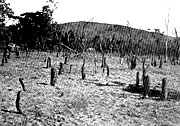
Burnt-over forest in Southern Rhodesia (Zimbabwe) in 1930. (Jacks and Whyte)

Our hill farm when we arrived: trees cut down, terraces broken, all the soil washed away.
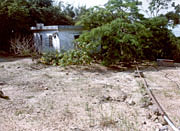
Nothing grew in the exposed subsoil except a few sprigs of pest grass.
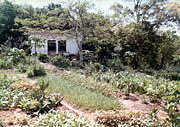
Eight months later it was bursting with crops.
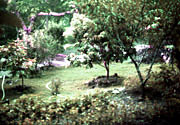
Five years after we left -- lawns, shrubs, and fruit from the trees we'd planted.
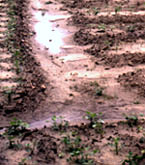
Village crops wrecked, beds ruined and soil washed away in a tropical storm.
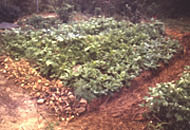
The same storm did no damage to our no-dig beds -- no soil lost.
"More than petrol or land, it is over water that the most bitter conflicts of the near future may be fought," Mayor said.
"The wars of the next century will be about water," warned Ismail Serageldin, World Bank Vice President and Chairman of the Global Water Partnership, in 1995, and again in 1999: "Severe conflicts due to competing claims for water may erupt from what are increasingly rancorous disputes over water."No trees, no soil, no water – desert
Today, the deserts are spreading at the rate of five million hectares a year worldwide (not yet quite as fast as the forests are vanishing). A third of the world's land surface is at risk from desertification, threatening the livelihoods of more than 850 million people (United Nations Development Program).
American researcher J. Russell Smith charted how this disastrous progression could be reversed by using special trees, especially in the hills. "When we develop an agriculture that fits the land, it will become an almost endless vista of green, crop-yielding trees," he wrote in Tree Crops: A Permanent Agriculture (1929).
-- "Agriculture in mountainous, rocky or dry regions is a disaster, but trees are salvation," wrote Fritz Schumacher, author of "Small is Beautiful: Economics As If People Mattered" and founder of the Intermediate Technology Development Group.
And "re-forestation" often replaces a mature forest rich in biodiversity with a biologically simple plantation.
It can be a different matter when projects are mounted at the local level -- forestry as if people mattered. There are many such projects, quietly planting trees where there were none, bringing multiple benefits to the local people who plant them and tend them, and to everybody else too, though you don't hear much about it.
In the news
Not in the news
References and resources
Trees for deserts: HDRA
Trees and forests -- resources for schools